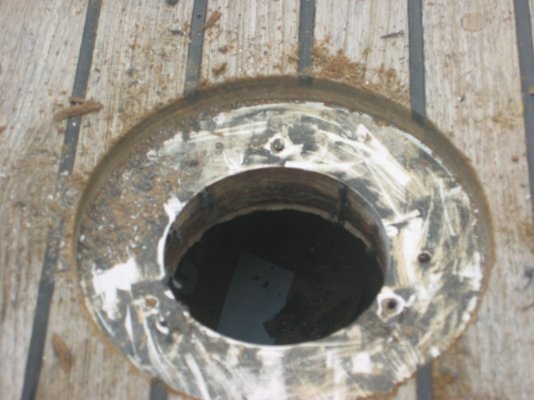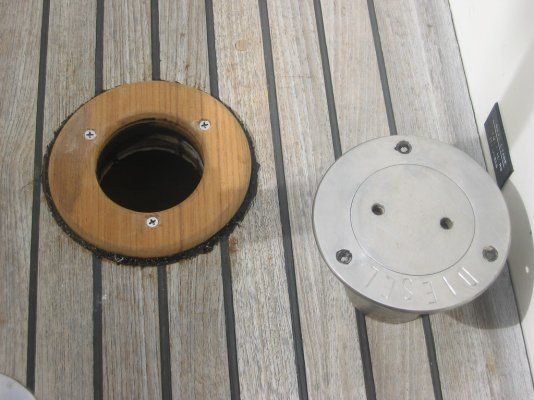I was screwing around in the engine room of BYE ALL and took out the false walls between the lehmans and the fuel oil tanks on both sides so I could better inspect the fuel tanks. Taiwan trawlers as many of you know cheeped out on the fuel tanks BIG TIME. No inspection ports, one light coat of exterior paint, no inner tank coatings and less than .125 CRS.
What I found wasnt good; I knew when I bought the boat that I would be replacing tanks sooner than later. They arent leaking fast, or even dripping but the exterior bottom (lowest corner) is wet like the fuel is seeping through.
So now im looking at replacing the tanks and this is my plan that I thought I would share.
There are three different approaches ive seen with removing fuel oil tanks from this style vessel. 1)* Cut out the bottom and let the whole tank drop, bolt new tank to hull that was removed and reglass it in place. Personally I would never even consider that.
2) Remove engine one at a time and pull tank whole that way. Requires building a crane system inside the salon to lift the heavy Lehman. Not doing that either.
3) From what I see this is the most popular and deff makes the most since to me. Drain the tanks and cut with a sawsall into smaller removable pieces. Then fab 3 tanks per side to fit in with no mods and plumb them together in the machinery space. Ive debated which material to use, steel, aluminum, stainless... they all have there own problems. I have settled on just .125 CRS. I have designed the tanks using ESPRIT CAD CAM software that I use for work. Very simple tanks 2ft square with 10 degree taper on bottom side to fit the hull.
I have the machinery to shear the plate to size and weld it in our shop so thats the easiest way. I dont have much experience welding aluminum, my brother does but the original steel tanks have lasted 29 years and are .090 thick.
Better built tanks with proper inspection ports and drains should last more then that.
im am going to reduce the capacity from 500 US GAL to 375 US GAL
I will keep you all updated with the process and hopefully it goes as planned.
-- Edited by albin43 on Tuesday 30th of March 2010 06:14:35 AM
-- Edited by albin43 on Tuesday 30th of March 2010 06:17:46 AM
What I found wasnt good; I knew when I bought the boat that I would be replacing tanks sooner than later. They arent leaking fast, or even dripping but the exterior bottom (lowest corner) is wet like the fuel is seeping through.
So now im looking at replacing the tanks and this is my plan that I thought I would share.
There are three different approaches ive seen with removing fuel oil tanks from this style vessel. 1)* Cut out the bottom and let the whole tank drop, bolt new tank to hull that was removed and reglass it in place. Personally I would never even consider that.
2) Remove engine one at a time and pull tank whole that way. Requires building a crane system inside the salon to lift the heavy Lehman. Not doing that either.
3) From what I see this is the most popular and deff makes the most since to me. Drain the tanks and cut with a sawsall into smaller removable pieces. Then fab 3 tanks per side to fit in with no mods and plumb them together in the machinery space. Ive debated which material to use, steel, aluminum, stainless... they all have there own problems. I have settled on just .125 CRS. I have designed the tanks using ESPRIT CAD CAM software that I use for work. Very simple tanks 2ft square with 10 degree taper on bottom side to fit the hull.
I have the machinery to shear the plate to size and weld it in our shop so thats the easiest way. I dont have much experience welding aluminum, my brother does but the original steel tanks have lasted 29 years and are .090 thick.
Better built tanks with proper inspection ports and drains should last more then that.
im am going to reduce the capacity from 500 US GAL to 375 US GAL
I will keep you all updated with the process and hopefully it goes as planned.
-- Edited by albin43 on Tuesday 30th of March 2010 06:14:35 AM
-- Edited by albin43 on Tuesday 30th of March 2010 06:17:46 AM


